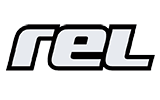Overview of speed-skating and of speed circuits around the world
Par alfathor |
Publié le 16 June 2007 |
Mis à jour le 3 November 2020 |
Catégories :
All
Speed-skating
All
| Sous-catégories :
History of roller-skating
History of roller-skating
| 10838
| Tags :
speed-skating circuits
speed skating competitions
speed skating events
The overview of speed skating circuits around the world is quite contrasted: the discipline stays behind the door of the sports which entered the Olympics, the historic sponsors cut their investments into the professional teams. Stock taking…
A low-key landscape
A short history of speed skating in France
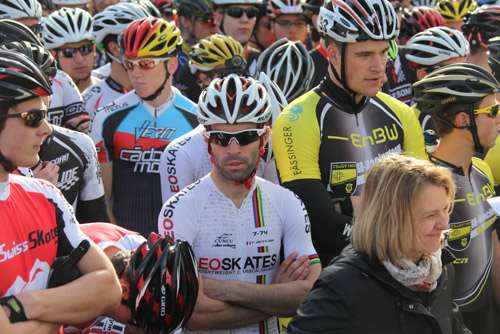 Speed skating was one of the founding disciplines of the F.P.R.F. – Fédération des Patineurs à Roulettes de France, the French Federation of Rollerskaters. Born in 1910, the FPRF organized the first French Championships at the Palais des Sports that same year (Nieswizski, 1991).
Speed skating was one of the founding disciplines of the F.P.R.F. – Fédération des Patineurs à Roulettes de France, the French Federation of Rollerskaters. Born in 1910, the FPRF organized the first French Championships at the Palais des Sports that same year (Nieswizski, 1991).
There were 3 disciplines at the time:
- Rink hockey
- Figure skating (Artistic skating)
- Speed skating
At the time, skaters used traditional quad skates. They prevailed until the mid-90’s when they were outshone by inline skates. Since then, equipment has never stopped improving.
After a considerable boom in the 90’s-00’s, speed skating goes through tormented times. In that article we will try to take stock of the evolution of the practise through an analysis of the national and international circuits, the structuration of the professional teams and the implication of the sponsors…
The national and international circuits
Meanwhile, lots of countries saw their national circuits get structured:
- The Swiss Inline Cup (Switzerland)
- The World Inline Cup (World)
- The French Inline Cup and the French Cup of Skating Marathons (France)
- The German Inline Cup (Germany)
- The Austrian Inline Cup (Austria)
And more recently:
- The Asianic Inline Cup (Asia)
- The Nachwuchs Cup
- The Ba-Wu Cup
- The NSC Circuit (National Speed Skating Circuit in the USA)
- The National Roller Cup (North America)
- The European Cup
- The Swiss Skate Tour
The Swiss Inline Cup: the first structured circuit
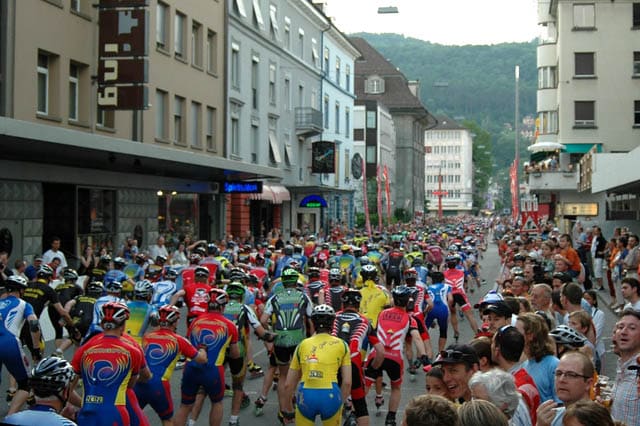 At first, the historical circuit of marathons was organized in Europe. National races emerged in Switzerland, in France then in Germany.
At first, the historical circuit of marathons was organized in Europe. National races emerged in Switzerland, in France then in Germany.
In Switzerland in 1994, at the instigation of Coni Altherr, was born Iguana, the company that will later organize the Swiss Inline Cup. The first edition saw 150 skaters take the start. The following years, the concept shot up, reaching 10.000 participants in 1998. That same year, Iguana launched the European Inline Cup.
The Swiss Inline Cup was one of the first Marathon circuits to get structured with races gathering several thousands of skaters at their starts. At the same time, some demonstrations and competitions of other skating practices would tag along.
In 2005, Coni Altherr decided that his company and the market of skating needed new owners, who would be able to offer even more development and perspectives. In 2006, a new holding was organized: Global Sports Group Ltd (GSG). It acquired Iguana in its entirety, reaching a turnover of 3.6 millions of Swiss Francs (around 2.7 millions of Euros). All the aspects of the Swiss Inline Cup were then managed by that company: vehicles, tents, etc.
The use of those resources happened not to be optimal and too much focused on Switzerland whereas the aim was to establish a leadership of the WIC at an international level.
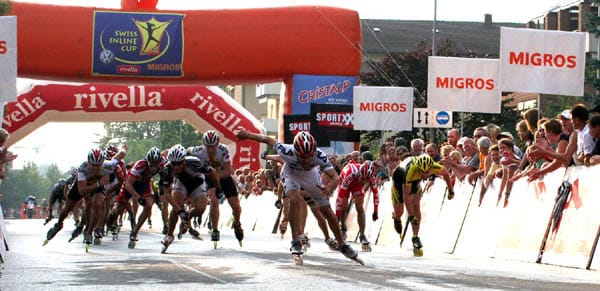 Thus, in 2007 and 2008, a major reorganization of the company took place. The first step was that the Swiss Federation took charge of the organization of the Swiss Inline Cup. In January 2008, all the events and their logistics were outsourced to a new company: Cate-e-Motion AG, of which Iguana owned 30% of the shares. Cate-e-Motion AG became the logistics partner of Iguana from the 2008 season, while Iguana narrowed down its activities to the managing of the Swiss Inline Cup, to its marketing, the sales and the broadcasting of the event.
Thus, in 2007 and 2008, a major reorganization of the company took place. The first step was that the Swiss Federation took charge of the organization of the Swiss Inline Cup. In January 2008, all the events and their logistics were outsourced to a new company: Cate-e-Motion AG, of which Iguana owned 30% of the shares. Cate-e-Motion AG became the logistics partner of Iguana from the 2008 season, while Iguana narrowed down its activities to the managing of the Swiss Inline Cup, to its marketing, the sales and the broadcasting of the event.
In August 2008, Cate-e-Motion AG was called upon to become the promoter of the SIC for Iguana, operating (exploiting) the Swiss tour and the events at their own risk and in exchange for guaranteed annual fees, but under the continuous property of the brand/concept and the surveillance of Iguana.
The Swiss circuit, the most structured and the most flourishing by all appearances, witnessed a serious setback those last years, with an important drop of the number of participants, a withdrawal of the organizers, and financial difficulties.
Dying, the Swiss Inline Cup disappeared, probably dragging along the World Inline Cup in its fall. Let’s remind here that the two circuits were organized by the same private company: Iguana.
Today, the Swiss circuit tries to find a second wind with the Swiss Skate Tour pushed by Toni Fankhauser. Today is far from being a prosperous time, but the Swiss Skate Tour will start its second year in 2013.
The World Inline Cup: its golden age and its decay
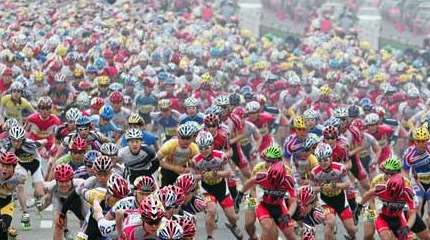 The World Inline Cup long relied on the Swiss circuit to develop.
The World Inline Cup long relied on the Swiss circuit to develop.
The World circuit was born at the instigation of the Iguana company in 2002. The concept mixes skaters of world level and leisure skaters in a festive atmosphere.
If the first competitions were European, the rise of the Asian market led to the organization of events in Korea and China. South America even saw races in Columbia and Venezuela.
In Europe, the Czech Republic and Spain joined the move late. In 2005-2009, the WIC finally became what it was aiming at: a series of skating events of international scope.
France also placed itself pretty well at that time with the big competitions of Rennes, Dijon and Nice. The French stages were part of the most renowned meetings, especially Rennes Sur Roulettes which was the first French stage to enter the WIC.
When the speed skating market started to get out of breath in Europe, it found a new energy in Asia in the early 2000’s, particularly in China and Korea. But today it must be noted that the WIC lost its glow of yesteryear, less races, less partners, and professional teams alarmingly decreasing.
4 or 5 years ago, there were still no less than 15 races. In 2013, 8 events were planned, none in Switzerland, none in Germany. Most of them were located in Asia and Eastern Europe, except for the two French stages.
The German circuit grows
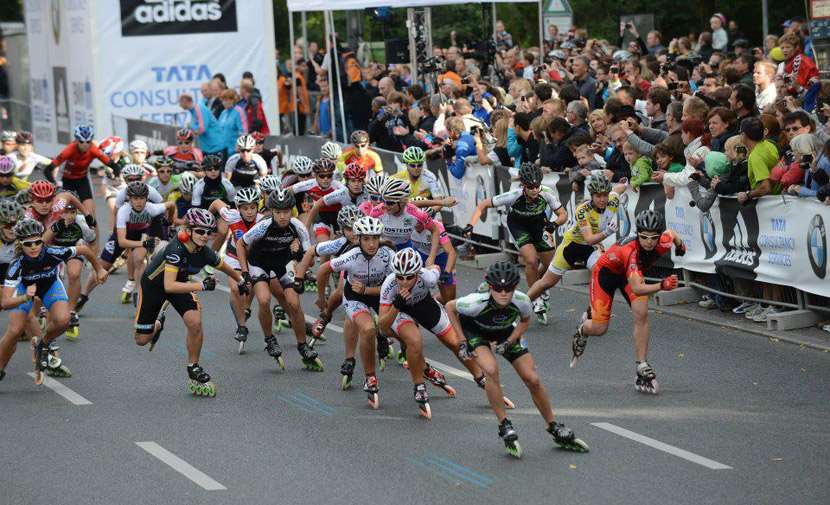 While the circuits around know contrasted situations, the German Inline Cup knows a continuous growth. The German competitions count between several hundreds and several thousands of skaters.
While the circuits around know contrasted situations, the German Inline Cup knows a continuous growth. The German competitions count between several hundreds and several thousands of skaters.
For example, Berlin exceeds 6.500 skaters and Cologne reaches 1.800 registrations. Surprisingly enough, the two greatest marathons of Europe are not even planned on the schedule of the World Inline Cup, proof of the bad health of the World Inline Cup!
The German figures:
- Berlin (skating, running): 6846 skaters in 2012
- Cologne (skating, running, handisport): 1800 skaters
- Semi-Marathon of Berlin Vattenfall (skating, running): 1922 skaters in 2012
- Coblence Mittelrhein Marathon (skating, running): around 1200 skaters
- X-Race & Geisingen: around 700 skaters
- No figures for Frankfurt…
The success of the German circuit seems to rely on the fact that most of the stages are combined with running races. Skating benefits from the logistics of running, for communication, the media, the tents, etc.
France: ups and downs and a situation stabilizing
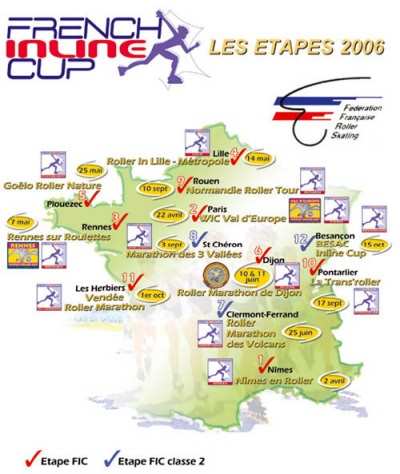 In France, speed skating emerged quite early with competitions such as Rennes Sur Roulettes. 2012 was the 30th edition, which brings us back to… 1982! The first international marathon took place in 1987.
In France, speed skating emerged quite early with competitions such as Rennes Sur Roulettes. 2012 was the 30th edition, which brings us back to… 1982! The first international marathon took place in 1987.
At the beginning of the 90’s, an embryonic circuit is organized with the France Tour of Loire. The seniors should remember the articles recounting the feats of Pascal Briand or Arnaud Gicquel in Roller Saga Magazine.
The French Inline Cup was born in 2000 at the instigation of the Roller Service company founded by Arnaud Gicquel, the French World Champion. The circuit is progressively on the rise with a growing number of dates.
In 2005, there were 13.565 skaters added up for 10 stages, including 21% of women and 79% of men.
The marathon category was made of 52% of elites, 40% of nationals and 8% of juniors.
In Open, the veterans 1 represented 44% of the skaters, in front of the seniors (42%) and the veterans 2 (14%).
In 2006, the schedule even reached the number of 12 competitions, but only 11 actually took place.
The next year in 2007, 11 competitions too.
In 2008, there were 9 competitions.
In 2010 the schedule dropped to 6 races. The French Inline Cup made room for the French Cup of Skating Marathons organized under the aegis of the Speed Skating Committee.
The French series took its independence towards the private contractors, economies of scale were made, especially on the timekeeping with the help of volunteers.
In 2011 and 2012, that independence enabled the French circuit to work despite a reduced number of partners. 2013 should unfold under the same auspices.
The American circuits
The NSC Circuit is an indoor competition between high level skaters, and it is more about the show. That private format has potential to seduce the media and announcers, but doesn’t have the same purposes as the mass competitions. The NROC (National Roller Cup) is closer to the European formats but seems to stagnate.
What should be remembered of all those experiences around the world?
First of all, we should remember that the balance is fragile for the organizers of the national and international cups! The Swiss Inline Cup had taken the good path in relying on a private organization with a culture of communication of marketing, but it would seem that a bad management sank the ship.
Besides, the economic context didn’t spare the competitions, the drop of the sales of skates at a world level led to the withdrawal of the main partners. Then followed the disengagement of the historic brands and de facto the decrease of the number of teams. The World Cup still survives but seems to be condemned in the medium term, despite a migration toward the East.
In a strictly marketing point of view, skating still has a hard time trying to sell its image. Big partners such as the car brand Kia, ready to invest a lot of money, quickly understood that the media benefits were not worth it. The vertuous circle is not easy to set up. No media means no sponsors, no sponsors means no development.
The most perennial model seems once again to be the German example, relying on the sharing with running races, thus draining the media, the partners and the skaters!
Links
Short story of the World Inline Cup
Translation: Chloé Seyres
Photos: rollerenligne.com and all rights reserved
